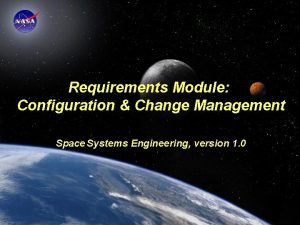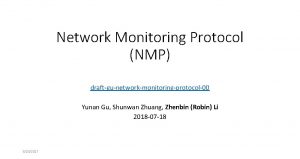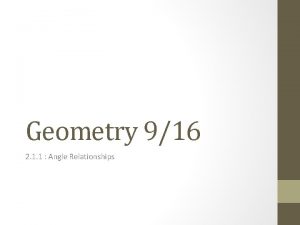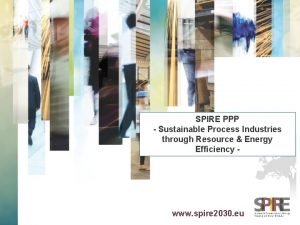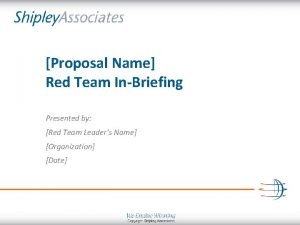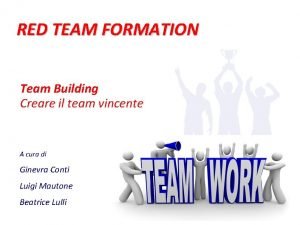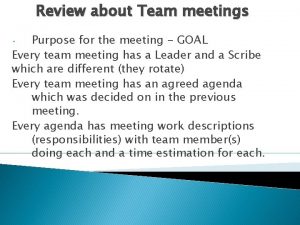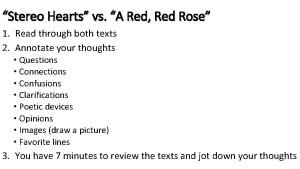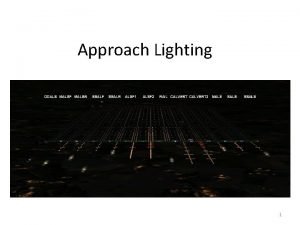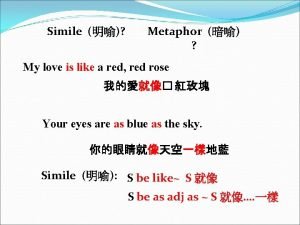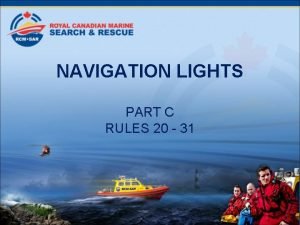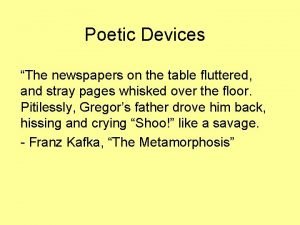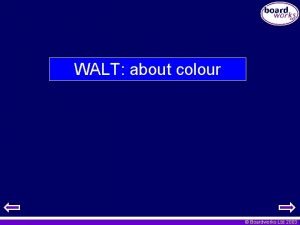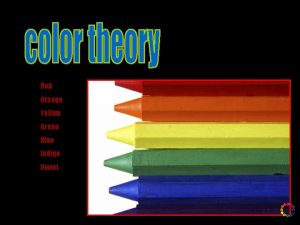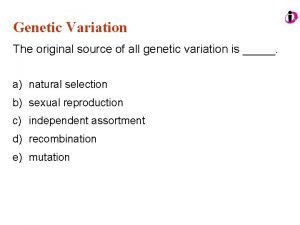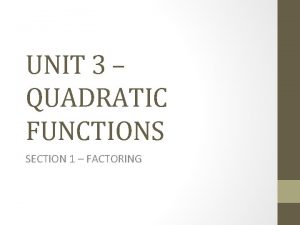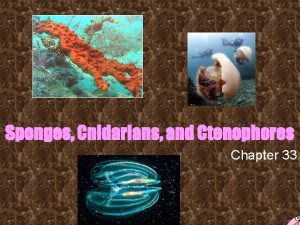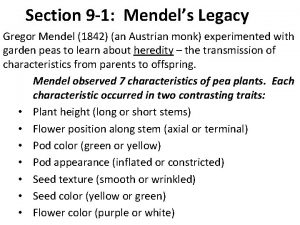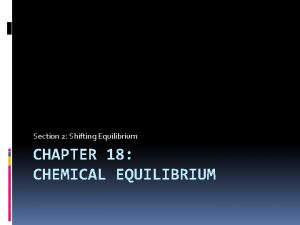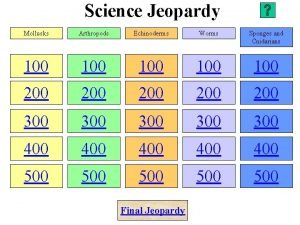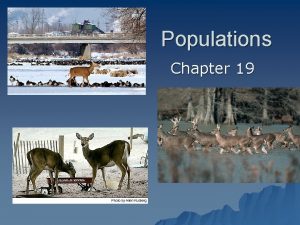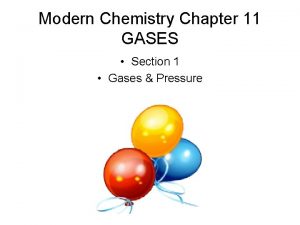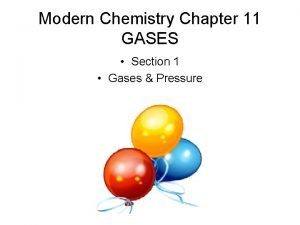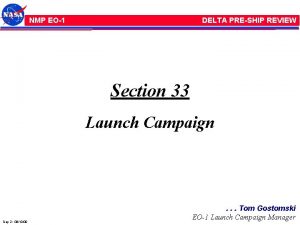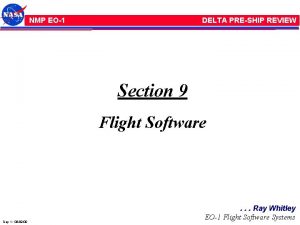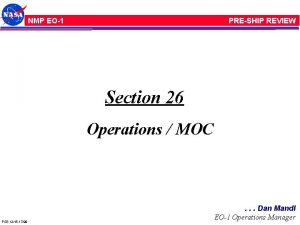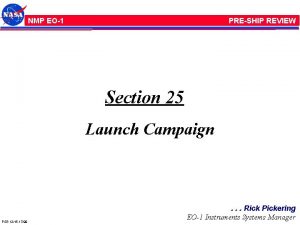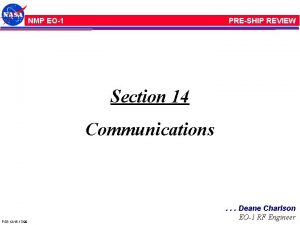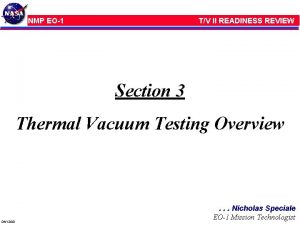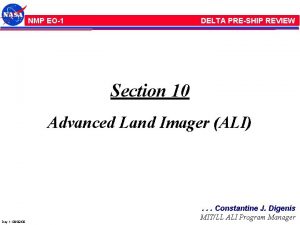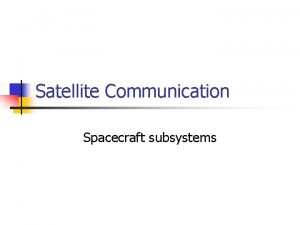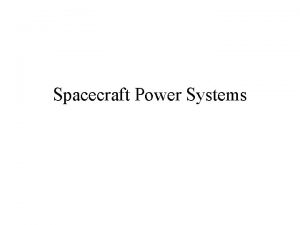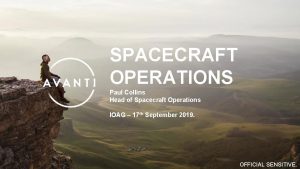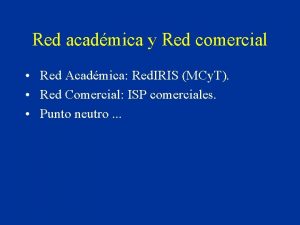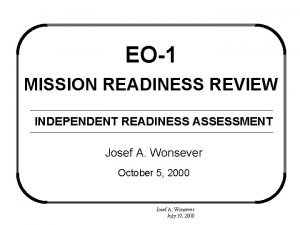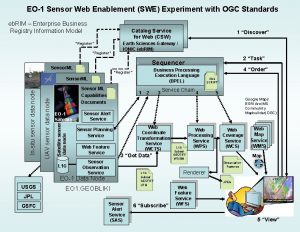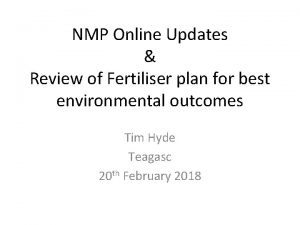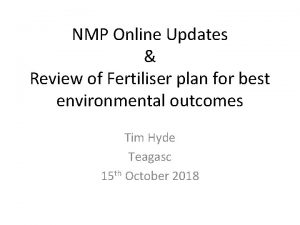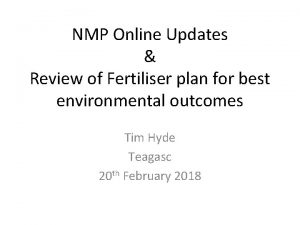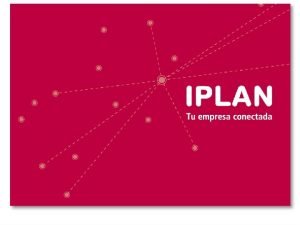NMP EO1 RED TEAM REVIEW Section 13 Spacecraft












































- Slides: 44

NMP /EO-1 RED TEAM REVIEW Section 13 Spacecraft Systems Management Approach Day 2: 03/29/00 . . . Mark Perry Swales Aerospace, 13 Inc. -

NMP /EO-1 Contents RED TEAM REVIEW u Requirements Verification – Process – Matrix u EO-1 Approach to Systems Engineering u Risk Management u Critical Resource Management – u u u Day 2: 03/29/00 Mass, power, and telemetry bandwidth Configuration Management – Drawings - Integration & Test Procedures – Software Spacecraft Quality Assurance – Design & Fabrication – I&T Program I&T Staffing 13 - 2

NMP /EO-1 RED TEAM REVIEW Requirements Analysis u u Day 2: 03/29/00 Traceability – Lowest level requirements traced back to the higher level requirements from which they were developed – Level One requirements tracked to source project document (EO-1 Project Plan) – Level Two and Three requirements become Derived to satisfy a Level One requirement or Allocated by an Interface Control Document Verification – Each lowest level requirement, for a given function, is verified by Analysis or Test & Evaluation – The requirement is traced to the Verification requirement (Test Plans) in addition to the verification performed (Test Procedures, Analysis Reports, and Work Order Authorizations) 13 - 3

NMP /EO-1 RED TEAM REVIEW Requirements Verification u u u Day 2: 03/29/00 System-level 1, 2 and 3 and subsystem derived requirements – Verified during integration and system tests – Functional requirements verified using functional test after each environmental test and each move – Performance requirements verified using CPT and other special tests before and after environmental testing Environmental requirements – Verified at box and satellite level – See Environmental Verification Matrix Software – Verified by developer, by EO-1 team in S/W lab, and on spacecraft in acceptance tests, regression tests, and CPT – Separate S/W verification matrix 13 - 4

NMP /EO-1 RED TEAM REVIEW Requirements Matrix LEVEL I REQUIREMENTS (Sample) LEVEL III REQUIREMENTS (Sample) REQMT ID Interpretation: Example 02. 3. 12 Interpretation: 02 - This requirement is a level 2 requirement. 3 – The requirement is item number 3 within the L-II requirements. 12 – This requirement is traceable to the next higher level requirement (L-I in the example) item number 12. Day 2: 03/29/00 13 - 5

NMP /EO-1 RED TEAM REVIEW Program Constraints u u EO-1 development was driven by cost and schedule – Design to cost: existing architecture and hardware, redundancy implemented to balance risk of single-string design – Build to cost: limited documentation, de-scope if necessary, rapid decisions, etc. Cost and schedule are as important as performance – If cost or schedule threatened, performance trades considered – Due to aggressive planning to incorporate the most advanced technologies, de-scopes occurred as the mission progressed – ALI WIS and GIS detectors – 1 Gb/s fiber optic data bus – Day 2: 03/29/00 The early design was realistically evaluated with respect to program constraints: “buy-ins” not considered on EO-1 13 - 6

NMP /EO-1 RED TEAM REVIEW Approach to Systems Engineering u Success depended on – Active interface control and monitoring – Quick decisions: key personnel using engineering judgement – Example: quick incorporation of Hyperion – Limited system documentation, particularly on design process – Lesson-learned: earlier documentation (e. g. , systems schematics, C&T handbook) would have saved time during integration & tests – u Selected redundancy implemented only on mission-critical systems consistent with Project constraints – u Day 2: 03/29/00 When evaluating system trades, took advantage of mission goal: technology development. For example, EO-1 is in standby mode for 90% of the mission. Solar array release mechanism, 1773 data bus, power harnessing, separate ACS safehold processor, main-computer memory source (EEPROMS), propulsion heaters Thorough and careful Integration & Testing – Detailed documentation of all integration procedures & anomalies – Caught errors not discovered during rapid development phase 13 - 7

NMP /EO-1 RED TEAM REVIEW Delegated Responsibilities u Managers and systems engineers identified and empowered lead engineers who have the initiative, capability, and dedication to take full responsibility for their system: performance, cost, schedule, and interfaces – u Day 2: 03/29/00 Responsible for all phases of development: design through on -orbit checkout This distributes the systems-engineering responsibility and ensures several checks on each interface – Minimizes the number of dedicated systems engineers, reducing cost – For example, the EO-1 engineer responsible for the structure also acts as the mechanical systems engineer: confirming interfaces and doing the system layout 13 - 8

NMP /EO-1 RED TEAM REVIEW Spacecraft Level Risk Management Process u Risk Identification Sources u Examples – Schedule – Cost – Performance – Use of core design personnel from development through operations – Recent anomalies on other Programs – Use of MAP design personnel during I&T process – During developments, risks identified, reported monthlies, and tracked to completion – During I&T, risks identified and tracked through PR system – – Limited Documentation Single String Design – Some elected redundancy under program constraints – Incorporation of fuse plugs for nonessential loads – Schedule/Cost – Descopes – ALI WIS and GIS detectors – 1 Gb/s fiber optic data bus – Augment team with GSFC & MAP personnel Day 2: 03/29/00 13 - 9

NMP /EO-1 RED TEAM REVIEW Sample of Monthly Risk Matrix Day 2: 03/29/00 13 - 10

NMP /EO-1 RED TEAM REVIEW Management of Critical Resources u Preliminary allocations developed for the Systems Design Review – u u Included reserves for mass and power and telemetry Resource use constantly monitored, with weekly reports – Deviations reported by subsystems as soon as discovered – Systems reallocates when necessary EO-1 allocations revised several times – In trades to reduce cost or shorten schedule – Example: allocate additional mass to structure to permit switching from a composite structure to an aluminum structure – In response to technical difficulties – Example: ALI required additional mass to meet stiffness requirement. – Day 2: 03/29/00 After as-built characteristics released reserve u Mass: after switch to Delta L/V, total mass became weak constraint u Telemetry: sufficient bandwidth for nominal and emergency ops u Power: the most-critical resource, particularly after adding Hyperion 13 - 11

NMP /EO-1 RED TEAM REVIEW EO-1 Mass Day 2: 03/29/00 u Subsystem weights were measured prior to installation on the satellite & the solid model is updated based on latest measured weights u Inertia properties are calculated from solid model u Final satellite mass will be within flight allocation – Allocation: 588 Kg – Final mass: 573 Kg, 2. 5% below allocation 13 - 12

NMP /EO-1 RED TEAM REVIEW EO-1 Power Use u Day 2: 03/29/00 Rack up of “as measured” powers for total system power for DCE and Standby orbits 13 - 13

NMP /EO-1 RED TEAM REVIEW EO-1 Telemetry Bandwidth Use Day 2: 03/29/00 13 - 14

NMP /EO-1 RED TEAM REVIEW CM Drawings and I&T Procedures u u u SAI EO 1 -CM-PLAN-001 Configuration Management Plan for the EO-1 Spacecraft (265 I&T Plans/Procedures not including Test Directives) – Covers the CM Process for all Swales generated Drawings and Hardcopy Test Procedures specific to the EO-1 Program – Process audited by outside ISO 9001 certification team and GSFC Code 300 (no discrepancies or changes required) – Subcontractors rely on in-house CM Plan/Procedures – Payload ICDs managed by GSFC CM All documentation reviewed and signed before work begins – Drawings updated following fabrication and assembly – Procedure redlines incorporated before re-running procedures – CM personnel co-located with I&T team to reduce process time Automated Test Procedures – Day 2: 03/29/00 STOL Procedures managed by EO-1 Lead Test Conductor. Changes to procedures require Data Base Change Request (DBCR) form with review by system/subsystem engineer. QA verifies that DBCR has been written prior to PR closure. 13 - 15

NMP /EO-1 RED TEAM REVIEW EO-1 Software CM u Visual Source. Safe – Flight Software stored in separate libraries – Problems & changes to source code documented with EO-1 Problem Test Report (PTR) number – Builds labeled on delivery to FSW Test Lab – After testing, code is copied from string by CD&H CM Manager – If needed, old builds can be retrieved from VSS – u u VSS can generate history report of code changes for each file PTR System – Changes to code done via PTR – Problems, design issues, and program improvements are logged – MAP PTRs tracked for issues applicable to EO-1 Delivery to Spacecraft for Test – Version Description Document (VDD) delivered w/ WOA for each new build & includes: – Description of change – PTRs implemented in the new build – Day 2: 03/29/00 Test Directive (TD) specifically calls out regression testing to be performed on load to fully test change on spacecraft 13 - 16

NMP /EO-1 RED TEAM REVIEW Quality Assurance Spacecraft Bus Elements u Overall Mission QA Requirements – u NMP/EO-1 Mission Assurance Requirements (MAR) Spacecraft Bus QA Requirements covered in: – SAI-QA-008, EO-1 Performance Assurance Requirements for Spacecraft Bus – Appendix A of SAI-QA-008 covers EO-1 EEE Parts Implementation Plan & Procedure. Plan conforms to the EEE parts requirements of GSFC 311 -INST 001 for Grade 3 quality level parts. The plan is similar & based on the MIDEX EEE parts requirements. – u I&T Work Order Authorization & Problem Report System process covered in SAI-PLAN-130, the EO-1 I&T plan u SAI-SPEC-158 EO-1 Verification Plan & Environmental Specification – Day 2: 03/29/00 Subcontractor/Vendor QA requirements are dictated in existing company documentation unless specifically addressed in EO-1 Specification/SOW Covers Verification Process and design/test environments 13 - 17

NMP /EO-1 RED TEAM REVIEW Quality Assurance Spacecraft Bus Elements Workmanship Standards u Day 2: 03/29/00 The following commercial, or NASA, workmanship standards are used for the EO -1 effort: – NHB 5300. 4 (3 M) Workmanship standard for surface mount technology – NHB 5300. 4 (3 A-2) or ANSI/J-STD-001 thru 006 (Hi Rel) Soldering of electrical connections – NAS 5300. 4(3 G-1) Cable, harness, & wiring interconnections – NHB 5300. 4(3 H) Crimping – NAS 5300. 4(3 J) Conformal coating and staking – IPC-D-275 [NASA alt. - NHB 5300. 4(3 K)] Printed wiring board design – EIA-625 [NASA alt. -. NHB 5300. 4 (3 L)] ESD control u Technicians required to be certified for the specific standard u Printed wiring board coupons evaluated at GSFC or by a GSFC approved laboratory. Approval required prior to population of printed wiring board. 13 - 18

NMP /EO-1 RED TEAM REVIEW Quality Assurance Spacecraft Bus Elements Work Order Authorization (WOA) System u The WOA System controls all work performed on the spacecraft u Initiated by Subsystem Lead or Test Conductor, and only authorized after the following actions: u u Day 2: 03/29/00 – Referenced Procedure released through CM – Signature of Systems Mgr. , Subsystem Lead, Mech. & Elec. Leads, I&T Mgr & QA Mgr. Following successful completion of work, WOA will be closed after approval from I&T Manager & QA – If a Problem Report is issued, the WOA remains open until PR is disposition & closed – Original WOA with supporting information will then be entered into S/C logbook WOA System uses an ACCESS 97 database developed specifically for EO-1 – Provides statistics on WOAs and Problem Records, – GSFC representative has full access to database at anytime & is invited to attend all meetings – Database is located on I&T network which will be portable to the Launch Site 13 - 19

NMP /EO-1 RED TEAM REVIEW Quality Assurance Spacecraft Bus Elements Work Order Authorization (WOA) System Day 2: 03/29/00 13 - 20

NMP /EO-1 RED TEAM REVIEW Quality Assurance Spacecraft Bus Elements Problem Records (PRs) and S/W Problem Test Reports (PTRs) u PRs are anomalous events that are inconsistent with expected results u PRs entered into the ACCESS database system & assigned numbers associated with the WOA under which the work was performed – u PRs must be dispositioned, corrective action taken and closed before WOAs can be closed – Day 2: 03/29/00 PRs are entered into the database system as they occur Closure of PRs requires approval from responsible subsystem lead & QA u PR meeting held typically every two weeks or as required to review status & develop corrective action plan u QA responsible to follow through with Subsystem Leads on closure u PTRs are analogous to PRs in Software environment. – PTR data base maintained by Hammers Co. – FSW-related PRs generated during S/C I&T have an associated PTR – FSW PR closure requires closure of the associated PTR – PTRs also are generated during FSW testing in software lab & MAP program 13 - 21

NMP /EO-1 RED TEAM REVIEW Quality Assurance Spacecraft Bus Elements PR Closure Process u Day 2: 03/29/00 Typical PR Meetings held with the following Representatives: – Responsible Subsystem Engineer (PR Assignee) – System Engineering – Swales Quality Lead – GSFC Quality Assurance Manager – Swales Program Manager – GSFC Mission Manager and or Observatory Manager u PR Closure requires agreement of all of the above u The PAR form used during spacecraft I&T replaces the Material Review Board Report form used during hardware development as referenced in the CERT Log 13 - 22

NMP /EO-1 RED TEAM REVIEW Quality Assurance Spacecraft Bus Elements WOA Status u Spacecraft I&T WOA Statistics – Total number generated as 3/24/98 through 3/21/00 = 952 – Note all work prior to 3/24/98 is covered in component/subsystem certlogs Day 2: 03/29/00 – Number Closed out = 924 (97% closure rate) – Open Work Orders = 28 (as of 3/21/00) – Work In Process =8 – Open PRs = 16 (two on WOA-829) – Close Out Work =3 – In Close Out Process =0 13 - 23

NMP /EO-1 RED TEAM REVIEW Quality Assurance Spacecraft Bus Elements Problem Report Status u Total number generated from 4/1/98 through 3/21/00 = 1572 u Number Closed out = 1554 (98. 9% closure rate) u Number open = 17 (as of 3/21/00) – Work In Process =9 – Test verification required =0 – In Closure Process = 5 (one potential Redbook candidate) – Redbook Items =3 – WOA 468 -20 -4 IRU Helium Exposure (see Special Topic) – WOA 770 -20 -3 One Time Event Chassis Current during EMC Testing (see Electrical Systems) – WOA 837 -20 -1 One Time Event LVPC Current Red Limit (see Power Subsystem) Day 2: 03/29/00 13 - 24

NMP /EO-1 RED TEAM REVIEW Quality Assurance Spacecraft Bus Elements Critical Problem Reports u Day 2: 03/29/00 In response to Pre-Ship Review Teams request the EO-1 Project Team has identified all Problems Reports that were generated from the start of Thermal Vacuum (10/1/99) that fall in the following categories: – Flight Hardware Changes – Flight Software Changes – “Use As Is” Classification/MOC Constraint Manual – Redbook items / unknown – Under investigation (as of 3/21/00) u All Problem Reports that are classified as critical, or that remain open as of 3/21/00, are addressed within the Subsystem presentations or in the Special Topic sections u Residual Risk has been assessed for all critical and open PRs u All open Problem Reports prior to the 10/1/99 were addressed in detail at the Thermal Vacuum readiness reviews (9/24/99, 10/1/99) 13 - 25

Quality Assurance Spacecraft Bus Elements RED TEAM REVIEW Pre TV NMP /EO-1 Open Problem Reports Day 2: 03/29/00 13 - 26

NMP /EO-1 RED TEAM REVIEW Quality Assurance Spacecraft Bus Elements Summary of Critical PRs as of 3/21/00 u 122 Critical Problem Reports, all closed with exception of 4 – 7 Hardware – Re-wire thermostats and heaters on nadir deck (3) (Special Topic) – Rework LFSA power and telemetry interface (Special Topic) – Reset ALI HOP – Repair WARP 5 -volt power service – Battery Trickle Charge Fuse (ground use only) – 78 Software (see S/W presentation) – Expected because of limited testing available in the S/W lab without ETUs – Many related to improved deployment logic (20) and failure monitoring implemented in the TSM system (20) – 33 “Use as is” / constraint manual – May add complication during operations, but not residual risk u Day 2: 03/29/00 – 2 (Post 10/1/99) Redbook items – 2 under investigation (WOA-949, WOA-943) Negligible residual risk due to the critical PRs 13 - 27

NMP /EO-1 RED TEAM REVIEW Spacecraft Problem Report Statistics from 10/1/99 to 3/20/00 Day 2: 03/29/00 13 - 28

NMP /EO-1 RED TEAM REVIEW RFA #2. 06 Delta Confirmation Review (RFA #6) u Define which spacecraft-level test will not be conducted with both flight instruments installed and the rationale and how the instruments will be tested to assure mission success (safe launch and successful on-orbit performance) – Day 2: 03/29/00 This RFA has been since overtaken by events since all the instruments were available for the start of the environmental test program. Therefore, there was no need to justify a separate spacecraft-level test program 13 - 29

NMP /EO-1 RED TEAM REVIEW Critical PRs not covered in other Sections Day 2: 03/29/00 13 - 30

NMP /EO-1 RED TEAM REVIEW Integration & Testing Staff Day 2: 03/29/00 13 - 31

NMP /EO-1 RED TEAM REVIEW Integration & Testing Staff Day 2: 03/29/00 13 - 32

NMP /EO-1 RED TEAM REVIEW Integration & Testing Staff Day 2: 03/29/00 13 - 33

NMP /EO-1 RED TEAM REVIEW Integration & Testing Staff Day 2: 03/29/00 13 - 34

NMP /EO-1 RED TEAM REVIEW Integration & Testing Staff Day 2: 03/29/00 13 - 35

NMP /EO-1 RED TEAM REVIEW Additional Systems Information Section 13 a . . . Mark Perry Swales Aerospace, Inc. Day 2: 03/29/00 13 - 36

NMP /EO-1 RED TEAM REVIEW EO-1 Mission and Subsystem Modes Switch to Internal Power * Turned ON during early Mission Ops ** Includes 30 W of survival heater power Day 2: 03/29/00 Separation from L/V 13 - 37

NMP /EO-1 RED TEAM REVIEW EO-1 Changes Since Environmental Test u LVPC fuses on non-critical services: full environmental testing u S/A release HOP fuses: environmental and functional testing u New s/w: all verified by extensive regression testing – M 5 – ACS: arctan, warm start time, validate GPS data using HK RSN flag – Time code: add GPS leap second – XB: 1773 request 2 words to prevent hangup – TSMs and RTSs: table loads – TO: jam limit on APIDs, filter tables, add GPS leap second Day 2: 03/29/00 – Read/write timing for all RSNs A/D conversion (except WARP RSN) – HK RSN: GPS, time processing, and deployment (auto-detect) – ACE: SHM inhibit, IRU event message, checksum – PSE and COMM: no change other than A/D read – X-band: open telemetry limits on FDC 13 - 38

NMP /EO-1 RED TEAM REVIEW EO-1 Changes Since Environmental Test (continued) Day 2: 03/29/00 u Nadir-deck heaters re-wired; bay-5 heater on new service; fully tested u WARP removed, repaired, tested, and re-integrated for TV test u ACDS removed, opened, x-rayed, workmanship vibe, and reintegrated u LFSA: power re-work, re-integrated with full functional test u AST removed, and filter replaced, workmanship vibe, and reintegrated u Replace trickle-charge fuse with diode: non-flight path u IRU removed (from Helium exposure), 5 of 6 vent holes closed, reintegrated u Hyperion electronics removed for access to panel: re-integrated 13 - 39

NMP /EO-1 Redundancy on EO-1 RED TEAM REVIEW u u u u Day 2: 03/29/00 1773 communications bus MV memory and processes area (2 PROMs and areas of RAM) Special hardware command path for contingency commands Thermal control system: power services, heaters, and tstats S/A release: power, HOPs, switches, activation, mechanisms Backup to GPS: time and position are up-loadable Independent processor for safehold attitude Dual coils on magnetic torquer bars RCS thruster valves and valve seats S/A drive: drive motors, drive electronics, and position indicators Battery temperature monitor S-band backup for science downlink TDRSS telemetry and commanding SSPC Power harnesses, S/A and battery wiring, BERB relays ALI thermal control system Backup device for opening ALI door 13 - 40

NMP /EO-1 RED TEAM REVIEW Built-In Redundancy that Contributes to Graceful Degradation u Multiple S/A strings u 4 GPS antennas 2 S-band antennas, on opposite decks 64 amplifiers in X-band phased array 22 battery cells and large capacity permits functionality after some failure modes Two WARP memory boards, each with multiple blocks Coupled thermal control u u u Day 2: 03/29/00 13 - 41

NMP /EO-1 RED TEAM REVIEW EO-1 S/C Risk Management Process - 1 u Mostly informal: process not well documented, – u Implementation is formal: PRs, PTRs, reviews, etc. Elements of risk management – – Top-level requirements and ICDs – Active management of ICDs, looking for problems Constant communication between subsystems – Weekly, full-team, technical review meetings – Monitor cost and schedule as additional problem indicators Emphasis on design margins and approved parts – Increases reliability in single-fault areas Internal review and peer reviews – Resulted in changes and risk mitigation – Insert redundancy where mitigated risk warranted extra cost and complexity – Review requirements during development; de-scope if necessary – Day 2: 03/29/00 Sacrifice performance rather than increase cost or risk 13 - 42

NMP /EO-1 RED TEAM REVIEW EO-1 S/C Risk Management Process - 2 u Elements of risk management (continued) – Examples of changes due to technical reviews – ACE safehold on independent processor – PSE H/W and S/W: analysis and changes – Extra ACS phasing tests – X-band near-field test – Fuse plugs – Second TV test – Active investigation and implementation of other-mission issues – IMAGE (PSE, DC/DC converters, etc), MAP (Flight S/W, AST, HSSR 7111 oscillations, etc. ), TIMED (S/A cell de-bonding) – Continued communication with the related missions – Comprehensive, rigorous, integration and system test – No sacrifices in documenting integration procedures – Identifies risks – Mitigates risks incurred during rapid development – Strict and thorough attention to PRs during I&T – Take advantage of delays to further retire risk – Additional testing, including contingency and simulation testing Day 2: 03/29/00 13 - 43

NMP /EO-1 RED TEAM REVIEW Top Risks and Mitigation on EO-1 u u u Day 2: 03/29/00 Single string failure possibility: LVPCs, MV processor, COMM RSN, transponder, ACS components, PSE RSN: mitigate by continued improvement of contingency procedures and continued review of parts vulnerability WARP recovery: mitigation is full environmental testing at box level, TV at S/C level Flight software: mitigation is 2 additional CPTs, 2 nd TV, and ops sims IRU sensitivity to helium: removed from S/C, purge until launch, close extra vent holes, improve purge lines AST quality: mitigation is complete (extra testing and parts review) u SSPC fuses trip at too high current; possible problem if 1. 5 to 2 ohm short: mitigated by TSMs and FDC u A/D anomalies: testing on MAP ETU to investigate cause 13 - 44
 Spacecraft requirements management
Spacecraft requirements management Eo1 opgave
Eo1 opgave Nmp protocol
Nmp protocol ∠lmn is a straight angle. find m∠lmp and m∠nmp.
∠lmn is a straight angle. find m∠lmp and m∠nmp. Nmp recovery system
Nmp recovery system Przedszkole nmp gdynia
Przedszkole nmp gdynia Proposal red team
Proposal red team Going native project management
Going native project management Team spirit becomes team infatuation
Team spirit becomes team infatuation The white team cheers for the blue team, just like
The white team cheers for the blue team, just like Vodafone red edge
Vodafone red edge Formation team
Formation team What is the goal of a red versus blue team exercise?
What is the goal of a red versus blue team exercise? Team review meeting
Team review meeting Simile in the song stereo hearts
Simile in the song stereo hearts Als approach lighting system
Als approach lighting system A red, red rose figures of speech
A red, red rose figures of speech My love is a red rose figure of speech
My love is a red rose figure of speech Red written in blue
Red written in blue White over red pilot ahead
White over red pilot ahead Poetic devices table
Poetic devices table Why does a red ball look red
Why does a red ball look red Indigo violet
Indigo violet Red and green
Red and green The original source of all genetic variation is _____
The original source of all genetic variation is _____ Chapter review motion part a vocabulary review answer key
Chapter review motion part a vocabulary review answer key Ap gov review final exam review
Ap gov review final exam review Narrative review vs systematic review
Narrative review vs systematic review Systematic review definition
Systematic review definition Narrative review vs systematic review
Narrative review vs systematic review Review packet section 1 factoring
Review packet section 1 factoring Cnidarians and sponges
Cnidarians and sponges Section 9-1 review mendel's legacy
Section 9-1 review mendel's legacy Chapter 18 review chemical equilibrium
Chapter 18 review chemical equilibrium Section 15-2 review evidence of evolution
Section 15-2 review evidence of evolution 5 advanced characteristics shared by cephalopods
5 advanced characteristics shared by cephalopods Section 19-1 understanding populations answer key
Section 19-1 understanding populations answer key Section 4 review physical science
Section 4 review physical science Chapter 9 review stoichiometry section 3
Chapter 9 review stoichiometry section 3 Modern chemistry chapter 14 review answers
Modern chemistry chapter 14 review answers Chapter 12 review solutions section 3
Chapter 12 review solutions section 3 Avogadro's law relationship
Avogadro's law relationship Chapter 11 review gases section 1
Chapter 11 review gases section 1 Chapter 9 section 1 labor market trends
Chapter 9 section 1 labor market trends Section 37-1 review the insect world
Section 37-1 review the insect world
